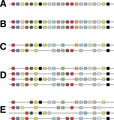File:Patró de gens - Hipòtesi 2R.png
Appearance

Size of this preview: 571 × 599 pixels. Other resolutions: 229 × 240 pixels | 457 × 480 pixels | 732 × 768 pixels | 975 × 1,024 pixels | 2,012 × 2,112 pixels.
Original file (2,012 × 2,112 pixels, file size: 79 KB, MIME type: image/png)
File history
Click on a date/time to view the file as it appeared at that time.
| Date/Time | Thumbnail | Dimensions | User | Comment | |
|---|---|---|---|---|---|
| current | 19:24, 14 July 2013 |  | 2,012 × 2,112 (79 KB) | Imartin6 | User created page with UploadWizard |
File usage
The following page uses this file:
Global file usage
The following other wikis use this file:
- Usage on de.wikipedia.org
